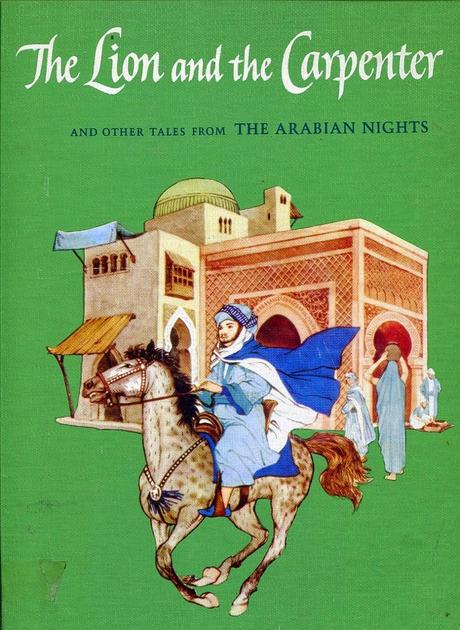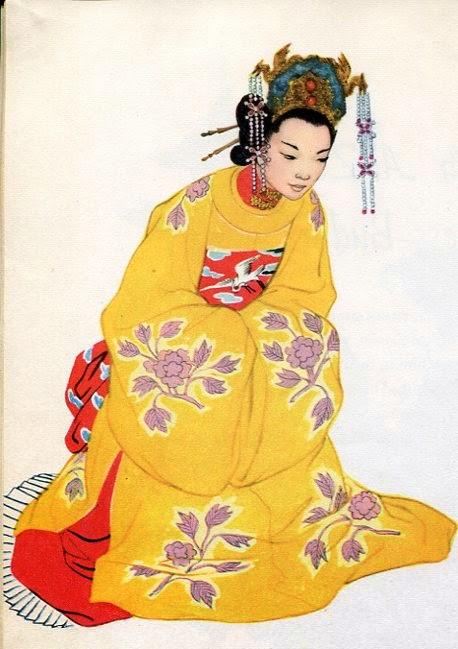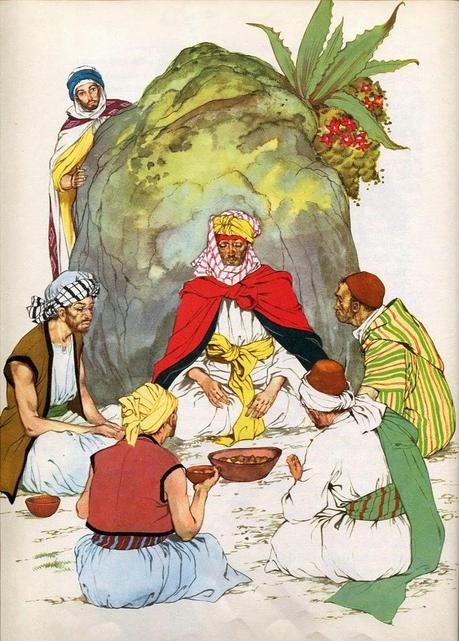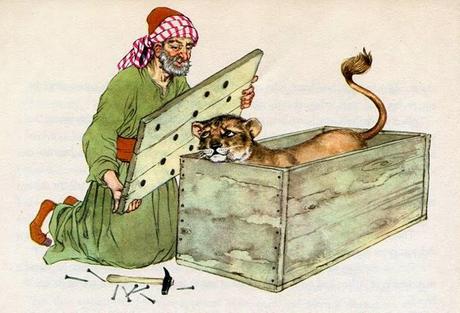 JEAN STAFFORD WAS THE ONLY CONTRIBUTOR other than Randall Jarrell to write the stories in her volume of fairy tales for Macmillan's 1962 series of oversized picture books, instead of just the introduction. In The Lion and the Carpenter and Other Tales from The Arabian Nights, Stafford's credit reads, "Retold and Introduced by Jean Stafford." Her included bio says:
JEAN STAFFORD WAS THE ONLY CONTRIBUTOR other than Randall Jarrell to write the stories in her volume of fairy tales for Macmillan's 1962 series of oversized picture books, instead of just the introduction. In The Lion and the Carpenter and Other Tales from The Arabian Nights, Stafford's credit reads, "Retold and Introduced by Jean Stafford." Her included bio says: "Miss Stafford...is the author of three distinguished and much admired novels (Boston Adventure, The Mountain Lion, and The Catherine Wheel), many short stories that have appeared in The New Yorker, Harper's Bazaar and elsewhere, and Eliphi, The Cat With The High I.Q., a book for children about her own cat of the same name."
 Stafford went on to win the Pultizer Prize for fiction in 1970 for her Collected Stories, but when she started working on her own versions of stories from the Arabian Nights for Michael di Capua's fairy tale series in 1962, she was seven years past her deadline for a new novel, and her most recent published novel was over a decade old. Writing the fairy tales was a way to avoid her more serious writing.
Stafford went on to win the Pultizer Prize for fiction in 1970 for her Collected Stories, but when she started working on her own versions of stories from the Arabian Nights for Michael di Capua's fairy tale series in 1962, she was seven years past her deadline for a new novel, and her most recent published novel was over a decade old. Writing the fairy tales was a way to avoid her more serious writing. Which didn't mean that she turned in inferior writing. In the plain language of fairy tales, Stafford retells the stories she selected with good humor and enough excitement for a reader to get lost in the telling. She explains in her introduction the Shahrazad frame narrative--the queen who must keep her husband in a constant state of anticipation by telling one story after another, or be killed in the morning--and that she chose "amazing happenings that are not quite so well known as the strange things that befell Sinbad in his wanderings, or Ali Baba's rapid rise from rags to riches, or the ups and downs of Aladdin's life when he became owner of his magic lamp." The stories are "Prince Kamar Al-Zaman and Princess Budur," "The Sandalwood Merchant and the Sharpers," "The Lion and the Carpenter," and "The Story of Abu-Kir and Abu-Sir."
Which didn't mean that she turned in inferior writing. In the plain language of fairy tales, Stafford retells the stories she selected with good humor and enough excitement for a reader to get lost in the telling. She explains in her introduction the Shahrazad frame narrative--the queen who must keep her husband in a constant state of anticipation by telling one story after another, or be killed in the morning--and that she chose "amazing happenings that are not quite so well known as the strange things that befell Sinbad in his wanderings, or Ali Baba's rapid rise from rags to riches, or the ups and downs of Aladdin's life when he became owner of his magic lamp." The stories are "Prince Kamar Al-Zaman and Princess Budur," "The Sandalwood Merchant and the Sharpers," "The Lion and the Carpenter," and "The Story of Abu-Kir and Abu-Sir."In "Prince Kamar Al-Zaman and Princess Budur," we learn of the most beautiful prince and the most beautiful princess in the world, who live many countries away from each other, unaware of the others' existence. A pair of genies, arguing over who is more beautiful, the prince or the princess, transports the sleeping princess to the sleeping prince's chamber so they can compare the two side-by-side. First, the prince, and then the princess wakes and sees the other one sleeping, and falls immediately in love. And once separated again by the genies, the two young lovers pine for each other for years, deathly sick with love until the princess's loyal brother manages to find her love and bring him to her.
 "The Sandalwood Merchant and the Sharpers" feels like a long joke. The sandalwood merchant goes to a distant city where he has been told that sandalwood is very valuable. Just before entering the city, a shepherdess warns him, "The people of this town are robbers and rogues, and their favorite sport is hoodwinking strangers." Despite the warning, the merchant is soon tricked out of his sandalwood for the promise of two handfuls of whatever he wishes, is accused of stealing a one-eyed man's eye, promises a cobbler whatever he desires for repairing his shoe, and ends up in debt to a gambler unless he drinks all of the water in the sea. Certain that he has caused his own doom, he meets the shepherdess again, who tells him that there is a wise man who all of the con artists consult at night to have that day's cons judged. The merchant finds this man, and hiding behind a rock, he hears the wise man explain to each of the con men how he could get out of their cons: He can request two handfuls of fleas, one of only males and one of only females, and when the man can't deliver, reclaim his sandalwood. He can demand that he and the one-eyed man each pluck out an eye to have them weighed in order to prove the one-eyed man's claim, and if they are equal in weight he will pay, but if not, the one-eyed man must pay him. Not wanting to be left blind, the man must drop the accusation. He can tell the cobbler that he has driven the sultan's enemies out of the country and that the sultan and his family are safe. If the cobbler says he is unsatisfied by this payment, he will be charged with treason. And he can tell the gambler that he will drink the sea, if the man brings it to him in a bottle. When the gambler is unable to, the merchant will be absolved of his debt. The sandalwood merchant enacts all of these solutions, sells his sandalwood at its proper value, and leaves the city rich.
"The Sandalwood Merchant and the Sharpers" feels like a long joke. The sandalwood merchant goes to a distant city where he has been told that sandalwood is very valuable. Just before entering the city, a shepherdess warns him, "The people of this town are robbers and rogues, and their favorite sport is hoodwinking strangers." Despite the warning, the merchant is soon tricked out of his sandalwood for the promise of two handfuls of whatever he wishes, is accused of stealing a one-eyed man's eye, promises a cobbler whatever he desires for repairing his shoe, and ends up in debt to a gambler unless he drinks all of the water in the sea. Certain that he has caused his own doom, he meets the shepherdess again, who tells him that there is a wise man who all of the con artists consult at night to have that day's cons judged. The merchant finds this man, and hiding behind a rock, he hears the wise man explain to each of the con men how he could get out of their cons: He can request two handfuls of fleas, one of only males and one of only females, and when the man can't deliver, reclaim his sandalwood. He can demand that he and the one-eyed man each pluck out an eye to have them weighed in order to prove the one-eyed man's claim, and if they are equal in weight he will pay, but if not, the one-eyed man must pay him. Not wanting to be left blind, the man must drop the accusation. He can tell the cobbler that he has driven the sultan's enemies out of the country and that the sultan and his family are safe. If the cobbler says he is unsatisfied by this payment, he will be charged with treason. And he can tell the gambler that he will drink the sea, if the man brings it to him in a bottle. When the gambler is unable to, the merchant will be absolved of his debt. The sandalwood merchant enacts all of these solutions, sells his sandalwood at its proper value, and leaves the city rich. "The Lion and the Carpenter" is a story within a story. A duck, "quaking and quacking as if she had had the scare of her life," explains to a pair of peacocks that she is afraid of "the son of Adam." She tells them of meeting a horse, a camel, and a donkey who were all running away from the son of Adam, because of the horrible things he would do to them. A lion prince reassured the other animals, however, promising to protect them all. But when the man, a carpenter, came, he tricked the lion into a box so that even the lion was defeated. The peacocks reassure the duck that the son of Adam can't reach them on their island, and that she should stay with them in safety. But years later, a group of shipwrecked sailors appear and eat the duck. When the men leave, the peacocks agree that the duck died, because he didn't praise Allah enough.
"The Lion and the Carpenter" is a story within a story. A duck, "quaking and quacking as if she had had the scare of her life," explains to a pair of peacocks that she is afraid of "the son of Adam." She tells them of meeting a horse, a camel, and a donkey who were all running away from the son of Adam, because of the horrible things he would do to them. A lion prince reassured the other animals, however, promising to protect them all. But when the man, a carpenter, came, he tricked the lion into a box so that even the lion was defeated. The peacocks reassure the duck that the son of Adam can't reach them on their island, and that she should stay with them in safety. But years later, a group of shipwrecked sailors appear and eat the duck. When the men leave, the peacocks agree that the duck died, because he didn't praise Allah enough. In "The Story of Abu-Kir and Abu-Sir," we are introduced to the nefarious dyer Abu-Kir and his friend, the noble barber Abu-Sir. For the first half of the story, Abu-Kir takes malicious advantage of Abu-Sir. Then, when Abu-Kir is in a position of wealth and power, instead of helping Abu-Sir, the way the barber had before, he has him beaten and thrown in the street. When Abu-Sir rises to a position of wealth and power himself, Abu-Kir accuses him of a plot to kill the sultan, and the sultan orders the good Abu-Sir's death. However, the truth is revealed, and Abu-Kir is rightfully killed instead.
In "The Story of Abu-Kir and Abu-Sir," we are introduced to the nefarious dyer Abu-Kir and his friend, the noble barber Abu-Sir. For the first half of the story, Abu-Kir takes malicious advantage of Abu-Sir. Then, when Abu-Kir is in a position of wealth and power, instead of helping Abu-Sir, the way the barber had before, he has him beaten and thrown in the street. When Abu-Sir rises to a position of wealth and power himself, Abu-Kir accuses him of a plot to kill the sultan, and the sultan orders the good Abu-Sir's death. However, the truth is revealed, and Abu-Kir is rightfully killed instead.JEAN STAFFORD's other children's book, Eliphi, The Cat With the High IQ, mentioned above, came out in the same year as The Lion and the Carpenter. Stafford never published for children again
I will get to Eliphi in a future post, and there are two more volumes in the Macmillan series that I hope to touch upon.
All images are copyrighted © and owned by their respective holders.

